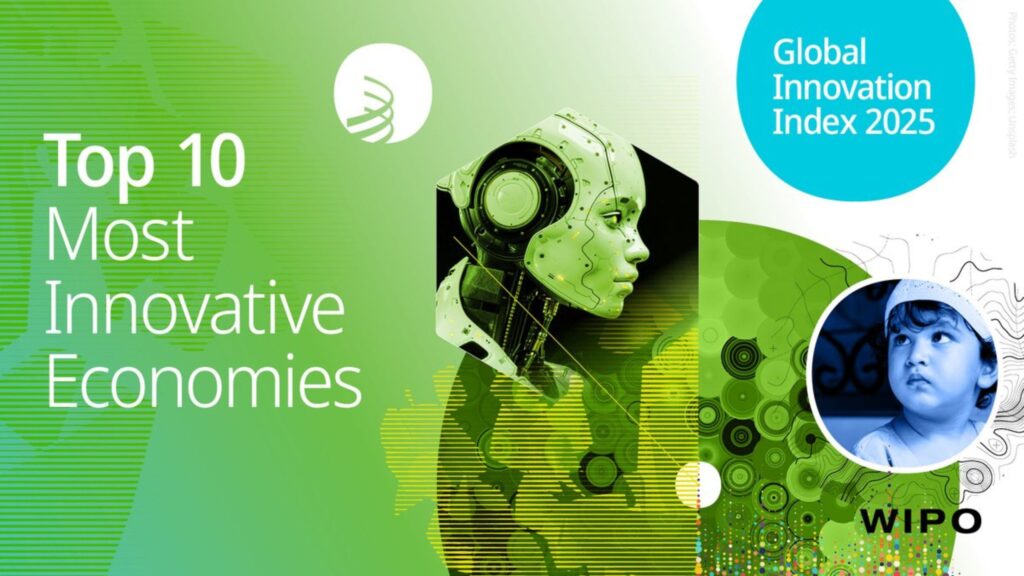Switzerland, Sweden, the United States of America (US), the Republic of Korea and Singapore top the World Intellectual Property Organization’s Global Innovation Index (GII) 2025 ranking, followed by the United Kingdom, Finland, Netherlands, Denmark and China, which breaks into the top 10 for the first time. Meantime, slowing growth in innovation investments is clouding the innovation forecast, the report found.
The GII uses some 80 indicators, ranging from research and development (R&D) spending, venture capital (VC) deals, high-tech exports and intellectual property filings in evaluating nearly 140 world economies on their innovative performance. It is the world’s benchmark resource for policymakers, business leaders and others in promoting innovation and building strong innovation ecosystems.
Now in its 18th edition, the GII shows that a group of middle-income economies—led by China, India (38th), Türkiye (43rd), Viet Nam (44th), the Philippines (50th), Indonesia (55th), Morocco (57th) – continue their climb in the GII. Since the turn of the decade, Saudi Arabia (46th), Qatar (48th), Brazil (52nd), Mauritius (53rd), Bahrain (62nd), and Jordan (65th), have been the fastest innovation climbers.
Global rankings
- Switzerland (Number 1 in 2024)
- Sweden (2)
- United States of America (3)
- Republic of Korea (6)
- Singapore (4)
- United Kingdom (5)
- Finland (7)
- Netherlands (Kingdom of the) (8)
- Denmark (10)
- China (11)
- Germany (9)
- Japan (13)
- France (12)
- Israel (15)
- Hong Kong, China (18)
- Estonia (16)
- Canada (14)
- Ireland (19)
- Austria (17)
- Norway (21)
”The GII 2025 maps the contours of innovation across the world, showing us that the fastest-advancing economies in the GII are those that view innovation as a fundamental engine of resilience, growth and competitiveness. This year’s GII reveals both encouraging progress as well as challenges that still need to be addressed for countries to fully harness their innovation potential. It is a reminder that innovation ecosystems require support and nurturing through thoughtful policies, meaningful investments and cross-sector collaboration”.WIPO Director General Daren Tang
In GII 2025, 17 low- and middle-income economies are performing above expectations for their level of development, with India and Viet Nam as longest-running innovation overperformers. Sub-Saharan Africa leads in the number of economies overperforming on innovation, with South Africa (61st), Senegal (89th) and Rwanda (104th) at the fore.
In addition to innovation rankings, the 2025 edition shows an uneven performance in leading indicators of future innovative activity.
Among the GII’s key findings:
- R&D growth fell to 2.9% in 2024, a slowdown from the 4.4% increase in the year prior and the lowest growth since the financial frisis of 2010. Growth is projected by WIPO to slow further in 2025 (2.3%).
- Corporate R&D spending in real terms slowed to 1% due to persistently high inflation —far below the 4.6% average of the past decade. ICT-related firms (particularly in AI-intensive sectors), software and pharma firms expanded R&D budgets, while manufacturing firms such as in the automotive sector and consumer goods cut R&D spend in a context of declining company revenues.
- VC investment values showed a rebound. Deal values rose 7.7% in 2024, largely driven by US-based megadeals and surging investment in generative AI. However, excluding these investments, VC value would have contracted.
- Furthermore, the number of VC deals fell 4.4% globally in a third consecutive year of decline, signaling persistent investor caution outside a narrow set of sectors and geographies.
- VC, which had been gradually expanding into a wider set of non-ICT sectors and emerging markets, now appears to be retreating toward its traditional core—namely the US-based AI- and ICT-related investments. This fails to sustain the earlier momentum toward broader sectoral and geographic VC diversification experienced just after the COVID-19 pandemic with strong VC influx into Latin America and Africa.
- Intenational patent filings via WIPO rebounded (+0.5%), with strong growth in the Republic of Korea (+7%), but continued declines in the US, Japan and Germany.
- Technological progress – a dimension covered in the GII Global Innovation Tracker – remained strong: battery prices and supercomputer efficiency improved, while the cost of genome sequencing declined further.
- Technology adoption advanced but slowed: Growth remained evident in robotics and connectivity; high-speed rail networks, a new indicator in 2025, expanded. In turn, robot and EV adoption experienced a marked slowdown.
- Socioeconomic indicators improved—labor productivity and life expectancy rose, poverty declined further.
Global leaders in innovation in 2025 – Regional Breakdown
South East Asia, East Asia, and Oceania
South East Asia, East Asia, and Oceania (SEAO) remains a driving force in global innovation in 2025, with six economies ranked among the top 25. The Republic of Korea (4th) and Singapore (5th) continue to lead the region, each with strong performances in business R&D, education and innovation infrastructure. China (10th) maintains its lead among middle-income economies globally and shows continued strength in R&D spending, high-tech exports and innovation outputs. Japan (12th) and Hong Kong, China (15th) both gain ground, while Australia (22nd) gains one position.
Nine of the 17 SEAO economies covered improved their rankings in 2025, with Hong Kong, China (15th), the Philippines (50th), Cambodia (100th) and Myanmar (122nd) making the greatest advances.
The Philippines breaks into the top 50 and ranks 3rd among lower middle-income economies, fueled by booming high-tech trade – deep integration in global value chains- and growing creative industries. Cambodia emerges as a leader in financial inclusion, topping global rankings in microfinance loans and ranking 2nd in overall credit. Strong foreign direct investment inflows and capital formation signal accelerating investment momentum. Lao People’s Democratic Republic (109th) also improves its position.
With an increasing concentration of innovation clusters – China alone hosts 24 of the world’s top 100 – SEAO remains central to global innovation dynamics.
Central and Southern Asia
Central and Southern Asia (CSA) shows strength on rising innovation outputs. Economies like India (38th), Uzbekistan (79th) and Kazakhstan (81st) are driving this with strong performance in entrepreneurship, tech exports, and knowledge creation.
India remains the top regional performer, advancing one rank and leading the lower middle-income group since 2022. India stands out for its ICT services exports, a vibrant VC landscape, late-stage VC and startup financing, unicorns and intangible assets – reflecting tech-driven growth.
The Islamic Republic of Iran (70th) ranks second in the region, followed by Uzbekistan (79th), which maintains its upward trajectory and overperformer status for a fourth year. It shows strength in labor productivity, science and engineering graduates, and education spending. Kazakhstan (81st) performs well in government digital services, and utility models.
Kyrgyzstan (96th) and Nepal (107th) also move up the rankings. Kyrgyzstan excels in education spending and low-carbon energy use, while Nepal leads globally in microfinance access.
Northern Africa and Western Asia
The Northern Africa and Western Asia region saw innovation momentum in 2025, with 14 economies improving their ranks.
Israel (14th) remains the regional frontrunner, reclaiming one rank and maintaining top global positions in R&D expenditure, business R&D, venture capital received and unicorn valuation. Cyprus (25th), the United Arab Emirates (30th), and Türkiye (43rd) follow as regional leaders. The United Arab Emirates reaches the top 30, excelling in business environment, ICT access and use.
While Türkiye slips, it ranks third among the upper middle-income economies and retains its leadership in trademarks and industrial designs. Saudi Arabia (46th) and Qatar (48th) hold firm in the top 50.
Morocco (57th) makes one of the region’s biggest jumps, with strong results in industrial designs, education expenditure, and labor productivity. It also ranks in the global top 30 for trademarks and intangible assets—signs of a maturing private sector. Bahrain (62nd), Jordan (65th) and Oman (69th) are fast risers, all breaking into the top 70, while Tunisia (76th) enters the top 80. Lebanon (90th) and Azerbaijan (94th) also inch upward.
The region overall shows resilience and continued progress, driven by deepening R&D capacity, growing IP activity and expanding innovation financing, even amid global headwinds.
Sub-Saharan Africa
Sub-Saharan Africa continues to make steady progress in 2025, with 10 economies improving their rankings. Mauritius (53rd) remains the region’s top performer, with South Africa (61st), Seychelles (75th), Botswana (87th) and Senegal (89th) following.
Mauritius excels in venture capital activity, particularly in VC investors. South Africa advances and maintains a strong position in ICT services imports and global brand value. Namibia (91st) makes the region’s biggest leap, climbing 11 ranks and leading the world in education spending. It also performs well in public–private research collaboration and FDI inflows, signaling a growing innovation ecosystem. Senegal rises three places and shows strength in unicorn valuation and microfinance access. Nigeria (105th), one of the fastest climbers this year, ranks 1st globally in unicorn valuation and shows increasing depth in high-tech imports and VC funding.
Rwanda (104th) continues its record as the region’s longest-standing innovation overperformer.
Five of the six new entrants to the GII in 2025 are from Sub-Saharan Africa—Seychelles, Malawi (125th), Lesotho (132nd), Guinea (133rd) and Congo (137th).
While structural challenges remain, the improvements this year reflect growing institutional capacity, stronger business ecosystems, and increasing momentum in entrepreneurship across the region.
Latin America and the Caribbean
In Latin America and the Caribbean, Chile (51st) leads the region, followed by Brazil (52nd) and Mexico (58th).
Chile continues to perform well in tertiary enrolment and market capitalization, while Brazil anchors the region’s innovation output. It has also strong results in education spending and private R&D investment. Brazil also remains the only economy in the region to overperform on innovation relative to its development level for the fifth year in a row. Mexico maintains a solid high-tech trade and manufacturing profile, ranking among the global top 20 in high-tech exports and imports and high-tech manufacturing.
Uruguay (68th), Colombia (71st) and Costa Rica (72nd) round out the region’s top performers, with Colombia excelling in unicorn valuation.
Panama (82nd), the Dominican Republic (97th) and El Salvador (98th) maintain stable positions. Panama (82nd) stands out for its labor productivity growth. Venezuela returns to the GII this year (136th).
The region’s persistent innovation input-output gap highlights the need to strengthen innovation linkages, improve institutional environments and expand access to effective innovation financing.
Northern America
Northern America remains the world’s most innovative region in 2025, anchored by the United States (3rd) and Canada (17th).
The United States holds firm in 3rd place, excelling in business sophistication, and leading the world in global corporate R&D investment, unicorn valuation, software spending and intangible asset intensity. Its innovation ecosystem is powered by dynamic startup funding and strong private-sector R&D, with 22 innovation clusters in the top 100. The San Jose–San Francisco cluster ranks 3rd globally and it is the most innovation-intense worldwide.
Canada stands out in innovation inputs, backed by top-tier universities and a robust venture capital ecosystem. It ranks in the global top 10 for university–industry collaboration and late-stage VC deals but continues to have challenges on innovation outputs, including its relatively low labor productivity.
Europe
Europe hosts 15 economies ranked among the global top 25, including six in the top 10. Switzerland (1st) retains the global lead, followed by Sweden (2nd), the United Kingdom (6th) and Finland (7th). Thirteen out of 39 European economies covered moved up the ranks, marking a notable increase from nine last year.
Notable movers include Ireland (18th), Belgium (21st) and Norway (20th), which breaks into the top 20.
Eastern European economies also show solid momentum. Lithuania (33rd) leads globally for unicorn valuation and digital innovation – with leading positions in app creation, ICT use and Knowledge-intensive employment.Europe is also home to dynamic innovation clusters, led by Germany with seven clusters and the United Kingdom with four, including Cambridge and Oxford. However, European innovation clusters trail the US in venture capital strength.
About the Global Innovation Index
The Global Innovation Index 2025 (GII), in its 18th edition this year, is published by WIPO in partnership with the Portulans Institute.
Since its inception in 2007, the GII has shaped the innovation measurement agenda and become a cornerstone of economic policymaking, with an increasing number of governments systematically analyzing their GII results and designing policy responses to improve performance. The GII Advisory Committee, the Industry Association Network (GIIIAN) and the Academic Network provide guidance.
Published annually, the core of the GII provides performance metrics and ranks around 140 economies on their innovation ecosystems. The Index is built on a rich dataset – the collection of 78 indicators – going beyond the traditional measures of innovation since the definition of innovation has broadened.
The GII 2025 is calculated as the average of two sub-indices. The Innovation Input Sub-Index gauges elements of the economy that enable and facilitate innovative activities and is grouped into five pillars: (1) Institutions, (2) Human capital and research, (3) Infrastructure, (4) Market sophistication, and (5) Business sophistication. The Innovation Output Sub-Index captures the results of innovative activities via two pillars: (6) Knowledge and technology outputs and (7) Creative outputs.
For each economy, a dedicated Innovation Brief is available through the interactive GII Innovation Ecosystems and Data Explorer 2025. These briefs provide a snapshot of an economy’s innovation performance, highlighting its key innovation strengths and areas for improvement. The online tool makes it easy to explore data trends, analyze world regions, and access downloadable datasets. The GII 2025 and Explorer also provides briefs on the the world’s top 100 innovation clusters – such as Shenzhen–Hong Kong–Guangzhou, San Jose-San Francisco or Cambridge.
The GII is submitted to an independent statistical audit by the Competence Centre on Composite Indicators and Scoreboards from the European Commission’s Joint Research Centre (JRC-COIN).



